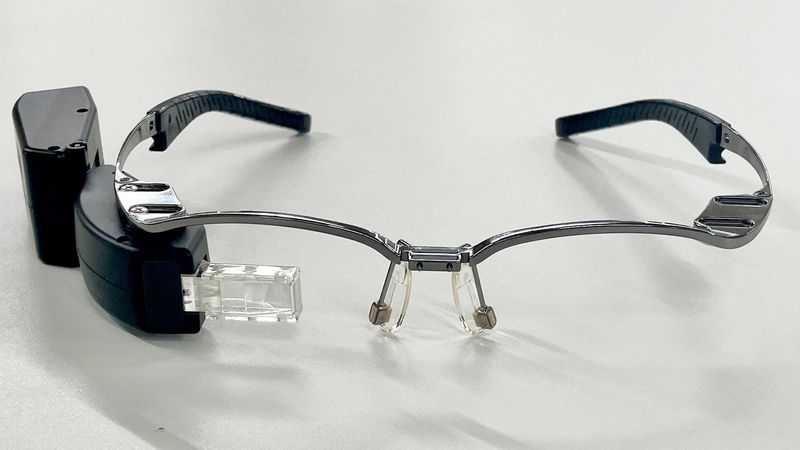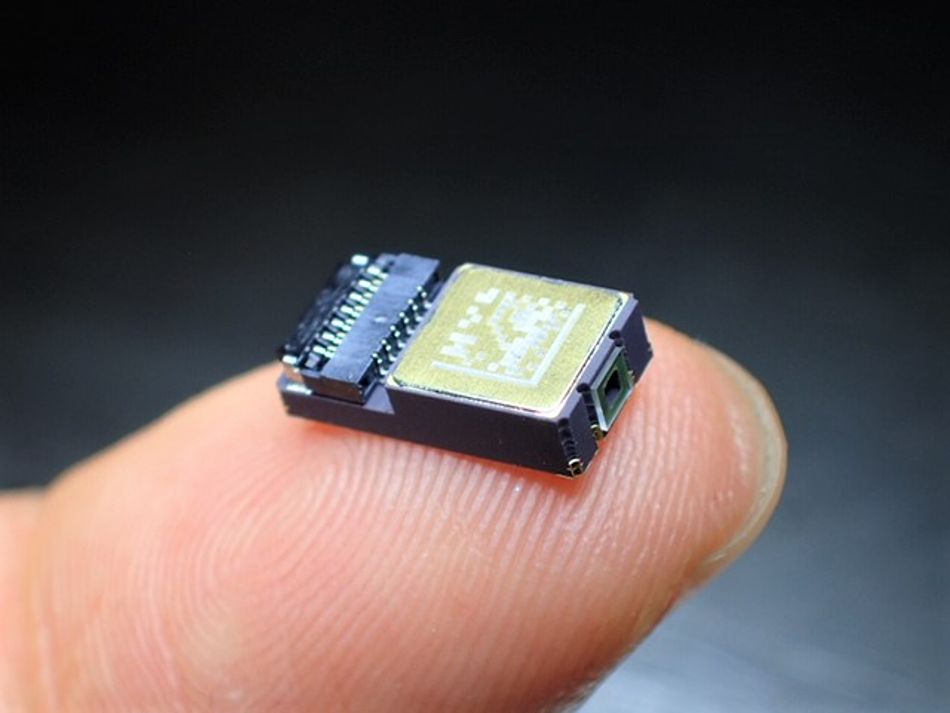Advancing AR Smart Glasses Realism: TDK's Full-Color Laser Modules Unleashed
TDK’s Full-Color Laser Modules (FCLM) introduce a paradigm shift in AR smart glasses display technology.

AR smart glasses.
The adoption of augmented reality (AR) smart glasses hinges on the ability of display technology to deliver true immersion. Achieving lifelike visuals requires displays with high resolution, vibrant color reproduction, and optimal power efficiency – all within the constraints of compact, wearable devices. While traditional display technologies have propelled AR smart glasses advancements, they present inherent trade-offs. For example, other type projections struggle with maintaining brightness and color uniformity in outdoor environments, or they require bulky optics that limit form factor miniaturization.
TDK’s Full-Color Laser Modules (FCLM) introduce a paradigm shift in AR smart glasses display technology. Engineered for ultra-compact integration, these laser modules use Photonic Integrated Circuit (PIC) technology to mix red, green, and blue (RGB) laser light into a single full-spectrum beam without the need for complex optical components, like half mirrors and lenses. This innovation enables industry-leading miniaturization and achieves high brightness and superior power efficiency compared to conventional displays.
A key breakthrough enabled by TDK’s laser modules is Direct Retinal Projection (DRP)—a cutting-edge approach that projects images directly onto the retina. DRP eliminates the need for screens and creates a natural depth effect that enhances clarity and reduces visual discomfort.
By integrating TDK’s compact laser modules, AR smart glasses and headsets can achieve an unprecedented balance of performance, efficiency, and user comfort, setting a new benchmark for next-generation immersive experiences.
Technical Foundation of TDK's Full-Color Laser Modules
Core Design and Miniaturization
TDK’s FCLM sets an unprecedented new standard in display miniaturization. Measuring just 10.8 x 5.5 x 2.7 mm and weighing only 0.35 g, these modules are designed to fit within the ultra-compact form factors required for AR smart glasses and head-mounted displays. Such miniaturization is necessary to find the right balance between high performance and lightweight, ergonomic wearability.
Whereas traditional spatial optical modules rely on bulkier optics with multiple alignment points, TDK’s FCLM employs PIC technology. This innovation unlocks the precise merging of RGB laser light (638 nm red, 520 nm green, 455 nm blue) within a photonic waveguide to eliminate the need for mirrors or lenses. As a result, TDK’s module achieves a 10X reduction in size while maintaining high optical efficiency.
Beyond its compact footprint, TDK’s proprietary Active-Alignment Assembly Technology accelerates production for a 150X improvement in assembly speed over conventional methods. With such an efficiency leap, manufacturers can achieve increased throughput and scalability for high-volume AR smart glasses hardware production.
Optical Characteristics & Performance
Central to TDK’s FCLM is a precisely engineered RGB laser system that delivers unmatched color accuracy and brightness. The module operates with red (638 nm), green (520 nm), and blue (455 nm) lasers, merging these wavelengths into a full-spectrum display for vibrant, high-contrast visuals with a wide color gamut that surpasses traditional AR smart glasses displays in fidelity and intensity.
One of the defining advantages of TDK’s laser display technology is its exceptional power efficiency. conventional display technologies require high energy consumption to maintain brightness, but laser-based projection systems only emit light where needed, reducing overall power draw. The result is significantly lower energy consumption and extended battery life in compact AR smart glasses.
In terms of resolution, TDK’s current modules support 1920x1080 (1080p) at 60 frames per second (fps) for fluid motion and clear, sharp images. The underlying technology, however, is scalable to 4K+ resolutions, paving the way for next-generation AR smart glasses experiences with ultra-high-definition visuals.
Direct Retinal Projection (DRP): The Game-Changer
Direct Retinal Projection fundamentally redefines how images are delivered in AR smart glasses systems. Instead of projecting visuals onto a traditional display panel, DRP beams light directly onto the user’s retina to create images that appear naturally integrated into their field of view. This method eliminates the need for bulky microdisplays and instead allows for ultra-lightweight, compact AR smart glasses that still deliver a sharp, high-contrast visual experience.
A major advantage of DRP is its ability to resolve the Vergence-Accommodation Conflict (VAC), thanks to the great features of focus-free. VAC is a persistent issue in conventional AR smart glasses where the eyes struggle to focus simultaneously on both virtual and real-world elements. By projecting images that naturally align with the user’s depth perception, DRP reduces eye strain and fatigue and makes extended AR smart glasses use far more comfortable.
Compared to conventional displays, which rely on screens and complex optics to display images, DRP eliminates distortion and significantly enhances clarity. Additionally, DRP achieves superior brightness without excessive power consumption so that virtual elements are more visible in a wider range of lighting conditions, including outdoor environments.
Other Advances: LiNbO₃ and Advanced Laser Modulation
Precision Alignment and Photonic Integrated Circuits (PIC)
One of the most complex challenges in laser-based AR smart glasses displays is the precise alignment of RGB laser beams. In traditional projection systems, aligning red, green, and blue lasers into a single, stable beam requires bulky optical components such as lenses and mirrors. Any misalignment results in color fringing, reduced image clarity, and optical inefficiencies that make high-quality image projection difficult to achieve in a compact form factor.
TDK overcomes this challenge with its Active-Alignment Assembly Technology, which achieves sub-micron accuracy in optical alignment. This process ensures that each laser beam is perfectly merged at the microscopic level, enhancing color fidelity and reducing image distortion. Whereas conventional approaches rely on manual adjustments, TDK’s precision alignment process is automated and optimized for high-speed, large-scale production.
Further improving performance, TDK integrates Photonic Integrated Circuits (PICs) into its FCLM. These circuits eliminate the need for traditional optical alignment components by routing laser light through compact waveguides on a chip. This reduces the size of the module and enhances long-term optical stability for consistently sharp and vibrant image projection with minimal power consumption.
LiNbO₃ (Lithium Niobate) for Fast Optical Modulation
TDK is pioneering the use of sputtered LiNbO₃ (Lithium Niobate) thin films to advance visible light modulation, a breakthrough that significantly enhances AR smart glasses display performance. Unlike conventional bulk LiNbO₃, TDK’s sputtered thin-film technology enables compact, mass-producible optical modulators that deliver ultra-fast response times and higher-resolution imaging.
A major advantage of LiNbO₃ is voltage-controlled color tuning, which replaces traditional high-energy laser diode modulation. This feature reduces power consumption while improving modulation efficiency and allows for precise and rapid color adjustments. By integrating LiNbO₃-based photonic chips, TDK’s laser modules offer enhanced clarity, faster refresh rates, and superior energy efficiency compared to conventional technologies.
Future Developments & Industry Impact
Looking to the future, there is still much room for growth in the field of AR smart glasses display technology.
Scaling Resolution Towards 4K & Beyond
TDK continues to push the boundaries of laser-based display resolution by developing next-generation high-density laser projection systems for ultra-HD AR smart glasses experiences. TDK is pioneering the use of LiNbO3 PIC chips for laser projection applications while maintaining compact form factors. These advancements will enable 4K+ resolution displays that significantly improve realism and visual clarity in AR smart glasses environments.
Reducing Power Consumption for Extended Wearability
Power efficiency remains a limiting factor for AR smart glasses wearables. LiNbO3 -PIC enables to realize power consumption for laser projection. This can lead to thermal energy utilization, to prolong battery life and enhance the practicality of all-day AR smart glasses wearability.
TDK in AR Smart Glasses Evolution
Future applications may expand into AI-driven holographic displays and spatial computing, where TDK’s precision laser modulation will help create interactive, real-time augmented environments.
Conclusion
TDK’s FCLM represents a major advancement in AR smart glasses display technology that delivers unparalleled brightness, resolution, and power efficiency in an ultra-compact form factor. By integrating PIC technology, TDK has eliminated bulky optical components while enhancing display clarity and energy efficiency to set a new standard for AR smart glasses wearables. Meanwhile, TDK’s DRP is a major breakthrough that eliminates the need for physical screens and resolves the Vergence-Accommodation Conflict that has long plagued AR SMART GLASSES users.
Looking ahead, laser-based AR smart glasses displays are poised for widespread adoption. TDK’s continued advancements in higer resolution like 4K or beyond, and realization of lower power consumption by adopting LiNbO3 PIC technology will further enhance AR smart glasses realism. As industry adoption grows, TDK’s laser modules will help drive the next wave of AI-driven holographic displays and spatial computing and unlock new possibilities for enterprise, consumer, and industrial applications. The future of AR smart glasses is being built on laser precision, and TDK is leading the way.
Get in touch with TDK to learn more about their vision of the Future of AR Glasses.

